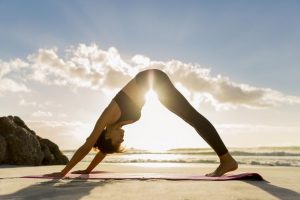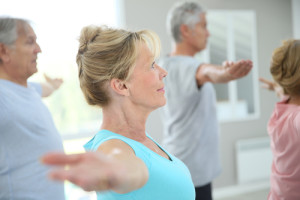Your body is designed for movement. It is a masterpiece of engineering with bones that can withstand compression forces twice as well as granite, and 600 muscles that permit movement ranging from Olympic athletics to playing the piano and brushing your teeth.
Your heart, arteries, veins, intestines, lymphatic circulation, bones, joints, liver and brain depend on vigorous movement in order to function well. Indeed mindbody health depends on physical exercise.
Our hunter/gatherer ancestors looked like the professional athletes that we watch on TV. They walked, ran and lifted everyday, sometimes for hours and days at a time. Their fitness program was life and survival. This is the wisdom of the body.
In modern times, we “don’t have time to exercise,” and yet we always find time to be sick. Our ancestors died of infections and trauma, while we succumb to cancer, heart disease, and diabetes, all of which are prevented by exercise.
Exercise and MindBody Healing
Helps to Prevent:
- Heart disease
- Cancer (risk reduced 35% by regular exercise)
- Osteoporosis
- Stroke
- Diabetes
- Obesity
- Depression
- Musculoskeletal problems such as low back pain, and tension headaches
Benefits Your Body:
- Increases oxygen to brain and all organs
- Lowers blood pressure
- Raises HDL cholesterol
- Decreases heart oxygen demand
- Increase heart strength
- Helps to reverse atherosclerosis
- Maintains good body weight
- Improves hormone production
- Elevates metabolism
- Improves fat metabolism
- Reduces abdominal fat
- Reduces insulin resistance
- Helps to reduce leptin resistance
- Reduces blood fibrinogen or “thick blood”
- Reduces CRP, another indicator of chronic inflammation
- Improves flexibility
Benefits Your Mind:
- Reduces stress

- Improve cognition (thinking)
- Prevents anxiety and depression
- Reduces anxiety and depression
- Improves self-confidence
- Improves self-esteem
- Reduces type A behavior
- Improves sexual function and desire
The key to fitness is movement:
- Walking instead of riding,
- Running instead of walking,
- Playing instead of watching,
- Using stairs instead of elevators,
- Carrying a basket instead of pushing a cart,
- Walking fast instead of slow,
- Dancing instead of sitting,
- Stretching instead of contracting,
- Take a Yoga class instead of watching TV,
- Play with your children
- Put a treadmill or elliptical machine in front of the TV
If you are over the age of fifty and have not exercised vigorously in the past, you should check with your doctor and possibly have a treadmill stress test before starting exercise training. Anyone with a history of heart disease should definitely see a doctor before fitness training of any type.
 Training Heart Rate for Vigorous Exercise
Training Heart Rate for Vigorous Exercise
The American College of Sports Medicine (ACSM) recommends aerobic exercise sessions of fifteen to sixty minutes a day, three to five days a week. The intensity of exercise can be governed by your training heart rate. The easiest way to compute this is to subtract your age from 220 – that’s your maximum heart rate – then take 60 percent and 80 percent of that number. The results are the upper and lower end of your target heart rate zone: while you exercise, your heart rate per minute should fall somewhere between these two numbers.
Rebounding (Cellular Exercise) – The Ultimate FItness Tool
 Regular exercise on the mini-trampoline, or rebounder, offers more benefit to your health than any other exercise, including jogging, swimming, walking and bicycling. According to NASA research scientists, rebounding is 68% more efficient than jogging.
Regular exercise on the mini-trampoline, or rebounder, offers more benefit to your health than any other exercise, including jogging, swimming, walking and bicycling. According to NASA research scientists, rebounding is 68% more efficient than jogging.
How can bouncing on this small trampoline about one yard across and 8 “high do so much? It is because gravity, or “G force” is used to your advantage, especially at the cellular level. You are weightless at the top of a bounce and then your body is feeling several G forces at the moment of hitting the trampoline and rebounding up again. During that moment of high G forces the muscles and bones of your body exert as if carrying heavy weights, but only for a fraction of a second. As you bounce you are getting the benefits of weight lifting without the risk of straining muscles, and, your heart and lungs are providing you with aerobic, oxygenating, exercise.
However, the most important benefit of rebounding occurs at the cellular level due to the effects of gravity on the movement of the lymph. The lymphatic circulation is the detoxifying system throughout your body, but this flow does not have a pump like your blood circulation. Exercise and deep breathing are the only ways to move the lymph and remove toxins from the cellular environment. The high G forces of rebounding provide the best exercise for improved lymphatic flow.
Dr Arthur Guyton, Professor and Chairman of the Department of Physiology and Biophysics at the University of Mississippi School of Medicine, is an international expert on the lymphatic system. According to Dr. Guyton, “the lymphatic group becomes very active during exercise but sluggish under resting conditions. During exercise, the rate of lymph flow can increase to as high as three to fourteen times normal because of increased activity.”
Stagnant lymphatic flow is a prime condition for many chronic diseases. It is found in many people due to sedentary lifestyles and shallow, unconscious breathing. Lymph congestion is associated with acidic conditions at the cellular level which in turn increases levels of viruses, bacteria and other pathogens and reduces oxygen levels. Low tissue oxygen is a prime factor in the development of cancer, as primitive cancer cells are fermentative and can only grow in oxygen deprived regions of the body.
 Dr. Robert Frost and his colleagues at the University of California in Los Angeles have studied the effects of rebounding on the body for some time. According to Dr. Frost, “The lymph system cleanses out toxic waste and health threatening bacteria. What bouncing does is improve the body’s own immunological system.”
Dr. Robert Frost and his colleagues at the University of California in Los Angeles have studied the effects of rebounding on the body for some time. According to Dr. Frost, “The lymph system cleanses out toxic waste and health threatening bacteria. What bouncing does is improve the body’s own immunological system.”
Indeed, there are extensive benefits to rebounding in every organ of the body and it also may provide an anti-aging effect. According to Dr. Robert Wear, and exercise physio9logist at the University of New Hampshire, rebounding can slow body deterioration in the elderly. It can halt bone loss and prevent joints from wearing out. He has noted that when the elderly exercise, ‘their appearance improves, their energy reserves increase, they eat better, their peripheral circulation improves and their range of motion increases.”
Elderly people can purchase a rebounder with a stabilizing bar to improve safety while exercising.
As with any exercise program, you should check with your doctor before starting to make sure your heart and lungs will tolerate the program.
I recommend the following link for more information and a look at the best rebounder on the market.
Healing is found naturally within the wisdom of your body and the power of your mind.

